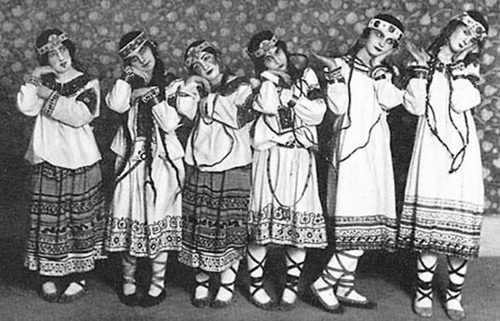|
Back in the seventies I was one of the first teenagers to take an ‘o’ level in ballet. There were only three of us and we were the first Hammond School girls to sit the exam. Every Saturday afternoon we’d arrive for our
history lesson, taught by one of the senior students who must have been all of eighteen years old. Sitting on an old sofa behind the studio, with our notebooks on our laps, we wrote pages of notes on the history of ballet from Sun King to Swan Queen. There were many lurid stories of quarrelling ballerinas, jealousies, love affairs and fatal accidents – but the most memorable must surely be the opening night of The Rite of Spring in the Théâtre des Champs-Élysées Paris 1913, a hundred years ago last week. We fourteen year olds tried to imagine the elegant Parisians enraged both by Stravinsky’s music and Nijinsky’s choreography -shouting, stamping, whistling – and the fighting that broke out between two opposing factions of the audience, creating such mayhem that Nijinsky had to shout instructions from the wings to the beleaguered dancers who could no longer hear Stravinsky’s impossibly difficult music. Sixty years on we couldn’t find anything in the music with its haunting melodies and powerful rhythms that might provoke such a riot, nor could we really understand how choreography could shock just because it deviated from traditional ballet. It was just a great story, an example we believed, of how dangerous art can be, and that’s how I always remembered it. It was only years later on reading ‘Natasha’s Dance – a Cultural History of Russia’ by the historian Orlando Figes, that I recalled we’d also learnt how Diaghilev - ever the showman - actually manipulated the audience response in order to gain publicity for the Ballet Russe. The audience had been primed to expect something truly shocking, and the polarisation of opinion about this new work was welcomed by the great impresario. And what of the audience – what did they really make of it all? What did they fear it would bring about? If they could speak a hundred years on what would they remember of that infamous night? What would stand out as important? Little over a year before the outbreak of World War 1, it must have been fun to express moral outrage about something as relatively insignificant as a work of choreography. The Rite of Spring certainly revolutionised music and ballet– but is art dangerous? I was once convinced that society could be changed for the better through the arts, and I spent several years working in arts and health to this end. Experience has cured me of such idealism. On the brink of Hitler’s rise to power, choreographer Kurt Jooss was well aware that his much acclaimed ballet The Green Table wasn’t actually going to prevent a war despite the bleak picture it portrayed. But this doesn’t detract from The Green Table’s powerful ability to reflect the human condition and the state of the world at the time, as well as its sense of prophecy. Dictators are dangerous, not artists.
0 Comments
Leave a Reply. |
AuthorTricia Durdey dances, writes, and teaches Pilates. Archives
October 2017
|

 RSS Feed
RSS Feed